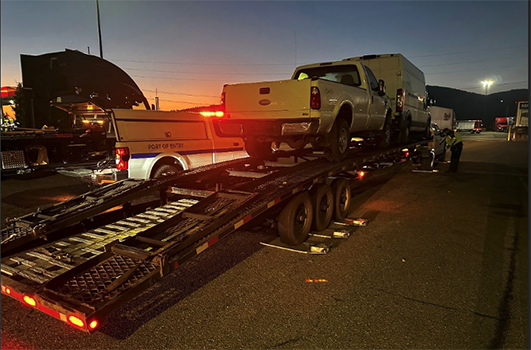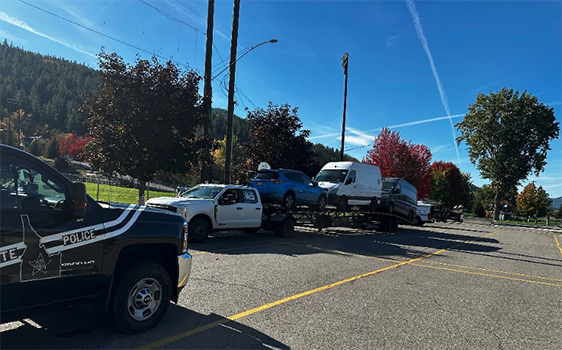From October 20-24, a group of POE inspectors from District 1’s Huetter Port of Entry collaborated on the Federal Motor Carrier Safety Administration’s nationwide Interstate 90 Corridor Hotshot effort. A hotshot refers to a specific vehicle towing configuration. The purpose was threefold — to ensure safety of the driving public, educate drivers in the proper way to configure and secure hotshot loads, and enforce proper documentation of registrations and permits.
An improperly configured hotshot load can create rollovers, jackknifing, and loss of control due to shifting weight and uneven distribution. Other risks include brake failure and longer stopping distances from overloading, and cargo coming loose to create a hazard for other drivers. If the load isn’t secured or configured properly, it also could cause trailer sway.
FMCSA coordinated with multiple state Commercial Vehicle Safety teams and Port of Entry agencies to concentrate a week’s worth of inspections on hotshot-configured loads. Specifically, the training focused on the 3,100-mile stretch of highway from Boston to Seattle, which passes through 13 states.
Pictured at right: As day broke on the morning of the October 24, District 1 POE personnel were hard at work inspecting vehicles, educating drivers, and ensuring loads were properly configured and legal.
The large two-tiered auto transporters you typically see on the road are designed specifically for hauling many vehicles at one time. Many smaller independent and commercial carriers use a “hotshot” to haul their cargo to their destination if they don’t have access to an auto transporter.
Hotshots are governed by trailer length only and not their overall length like auto transporters. If the vehicle configuration is not legal, like a trailer exceeding 53 feet on the national highway network, then an extra length permit is required to operate. That’s where our POE inspectors come into the picture.
Phillip Youngman’s team of skilled inspectors supported the event using the Huetter POE as their base of operations. Partnering with the Idaho State Police (ISP) and its specialized Commercial Vehicle Safety Alliance officers, Phil and his team focused their attention on hotshot configured vehicles weighing between 10,000 – 26,000 lbs. Typically, these loads are smaller than those required to enter our ports.
This was the second Hotshot-focused operation with ISP this year. The previous interagency collaboration was held June 10-11. Between ITD and ISP, over 100 hotshot configured loads were inspected and all deficiencies corrected on site.
“The partnership and cooperation benefits us all, and the work accomplished aligns precisely with ITD’s mission of promoting safety, mobility, and economic opportunity,” said Port of Entry Program Manager Frank DeCarvalho. “It was a job well done!”

